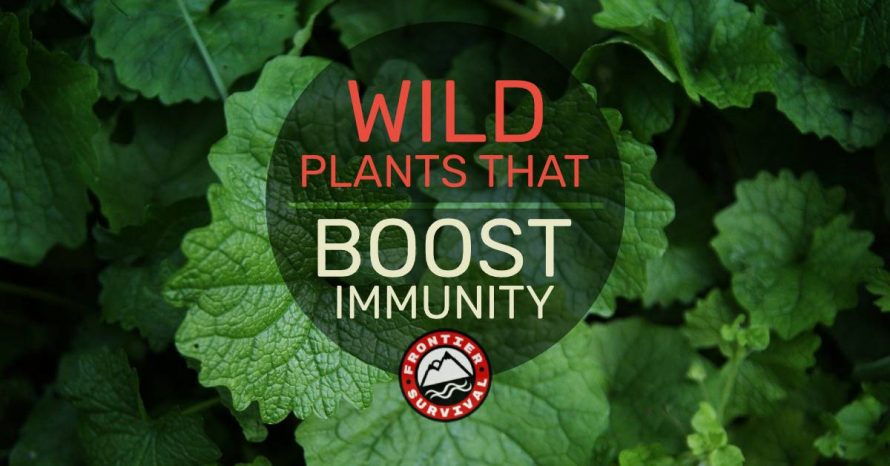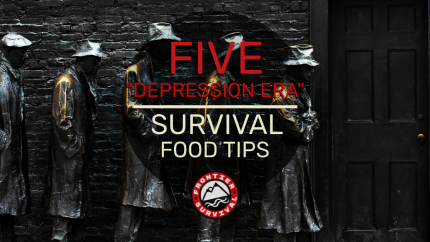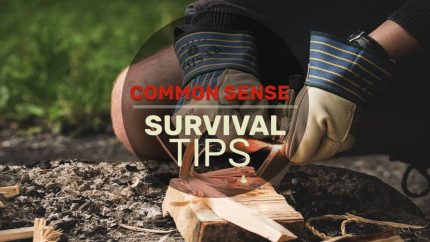Did you know that there are many edible wild plants in North America that can naturally help boost your immunity against the common cold and the flu?
By the time you finish reading this you will know exactly which ones to look for if you’re out in the woods and you feel a cold coming on.
EDIBLE WILD PLANTS AND VITAMIN C
There are so many wonderful wild edible plants that you can eat while foraging in the woods, and even in urban settings, that have more Vitamin C than the average orange.
One nutrient the human body cannot produce by itself is Vitamin C. We must get a digestible source from nature – especially when you can’t just buy some Vitamin C packets.
Of course, you could put a handful of commercially produced packets inside your bug out bag as a backup, but there are actually edible wild plants you can find that contain high sources of this immune boosting vitamin.
You should try to find and positively identify any of these plants where you live so that if you need them, you know where to find them.
HERE ARE 9 EDIBLE WILD PLANTS THAT ARE HIGH IN IMMUNITY-BOOSTING VITAMIN C
WARNING: Always use caution while foraging because some wild plants can make you very sick or even kill you! If you’re not absolutely sure something is safe then leave it alone, or get assistance from a professional.
#1 – Dog Rose (Rosa canina)

Though it doesn’t look like a typical rose, this beautiful wild edible won’t be hard to spot. Its five, slightly heart shaped petals can be white or pink with a plentiful center of yellow stamens.
It is a deciduous shrub so it’s closer to the ground than the typical rose bushes would be. It has thorns, and its leaves are green and serrated. Like typical roses, it blooms in Spring.
You can safely consume all of it’s parts including the leaves, petals, root and fruit. The fruit is the oval shaped rose hip that ripens in the fall.
The best thing about the Dog Rose is that it contains a whopping 1,250 mg of Vitamin C per 100g serving compared to the 53mg of Vitamin C you’ll find in 100g of oranges.
#2 – Blue Spruce Pine (Picea pungens)

Blue spruce pine trees are relatively easy to spot if you know what you’re looking for.
Spruce pines are conifers so they stay green, even in winter. They are found mostly in the West from Wyoming all the way out to the Oregon coast.
They have short pine needles and the new growth on them appears to have a blue tinge, making them relatively easy to identify.
Red spruce pine trees, which are more common in the East, near the Adirondak Mountain area, are also a good source of Vitamin C. They look very similar to the blue spruce, however the needles are more of a warm green and the branches are slightly shorter.
The needles of both have a pleasant taste and you only need a handful to give you the immune boosting vitamins. If you find yourself and your family out in the woods and in the cold, you can chew on them or boil them in water to make tea.
The Vitamin C content in both the blue and red spruce pine needles averages about 169mg per 100g serving.
#3 – Garlic Mustard (Alliaria petiolata)

This edible weed is considered an invasive species in the Pacific Northwest, which means it will probably be very easy to find in the west, but it can also be found across the country.
The greens have substantial amounts of Vitamin C, E, A and even B vitamins. It also contains substantial amounts of minerals including potassium, calcium, magnesium, copper and selenium.
The leaves, flowers, roots and seeds are all edible. Though its flowers don’t appear until May, the leaves can be eaten all year round, except during the hot summer months, when the greenery will taste more bitter.
It has a garlic-y smell and taste, and it can be added to savory dishes, dressings, and salads. You can eat any part of this plant too. The Vitamin C content of garlic mustard is about 190mg per 100g serving.
#4 – Common Blue Violet (Viola sororia)

There are many violet lookalikes so with this one, always make sure you are 100% sure you have found the Common Blue Violet.
This pretty “weed” is very common in the Central and Eastern US and it goes by a few names including but not limited to the purple violet, hooded violet and the lesbian flower.
Regardless of the name though, the Cherokee people ate the purple flowers to treat colds and headaches, which should give you some confidence that finding this beauty in wooded areas can be of use if you need an immune boost.
Common Blue Violet will deliver an average of 130mg of Vitamin C per 100g serving.
#5 – Lambs Quarters (Chenopodium berlandieri)

Also called “pitseed goosefoot”, you can find this plant almost anywhere, in the Americas and as far North as Canada. To some, it’s a weed, to others it’s a nutrient dense wild food.
It can grow to be 4ft high, has serrated lower leaves and has clusters of seeds that resemble little broccoli-like flowering shoots.
It’s a close relative to quinoa and its leaves can be eaten (and tastes a bit) like spinach. This is an incredible plant because it is packed with essential vitamins and minerals.
It’s a great source of Vitamin A, and also B complex vitamins including niacin, thiamine and riboflavin – which all play a vital role in your metabolic functioning. In addition to these nutrients, lambs quarters is also an excellent source of Vitamin C, containing 130mg per 100g serving.
#6 – Elderberry (Sambucus)

The elderberry is a deep purple color rich in anthocyanins, which is the compound responsible for its deep color. Though the ripe cooked berry from this tree is edible, the leaves, stems, roots and flowers can be toxic – so do not eat them.
Eating the berry raw can cause illness and nausea due to its high cyanogenic glucoside content so the berries must be fully cooked. Not steamed, not juiced, not made into tea, but cooked – fully.
Finding elderberry while foraging may not be as easy as some other high nutrient plants, but if you’re lucky enough to stumble upon an elderberry shrub keep in mind that it may be up to 15 feet tall!
Its compound leaves are oblong in opposing leaflets on the stem. The berries are deep purple and almost black in color when ripe, and form small umbrella shaped clusters.
The berries contain about 116mg of Vitamin C per 100g serving.
#7 – Shepherd’s Purse (Capsella bursa-pastoris)

Another relatively easy to identify nutrient dense wild edible is shepherd’s purse. It got its name because the pods or fruit of this plant resemble small heart shaped purses.
The lore is that its name was derived from the time when shepherd’s from the 1600’s would carry their food and drink in leather pouches tied with string that looked like purses, and the plant fruits are very similar in likeness.
It’s part of the mustard family of plants with leaves that resemble dandelion leaves in that, they have deeply toothed leaves at the base. Its flowers are white and small with four petals and the flowers bloom in small clusters.
Unlike most flowering plants, shepherd’s purse can flower all year long. The pods contain seeds that are “mucilaginous” and can taste peppery, but aside from that they contain 91mg of Vitamin C per 100g serving.
#8 – Mock Strawberry (Duchesnea indica)

Also called “false strawberry”, this plant is a ground creeper that resembles true strawberries. The major differences between the mock strawberry and a common strawberry are, with mock strawberries the flowers are yellow as opposed to pink or white, as with common strawberries.
The fruit is much smaller in size, and shaped like a globe with protruding “ovaries” that contain a single seed. True strawberries are larger and the seeds lay flat with the surface of the fruit.
Additionally, mock strawberries, although edible, apparently have little overall flavor and are not very juicy.
Of course, flavor is not solely what we’re going for in an emergency situation but luckily mock strawberries do contain 70mg of Vitamin C per 100g serving.
#9 – Dandelion (Taraxacum)

The dandelion is one of the most common and pervasive edible weeds of them all. You can find it in your yard, popping up through the cracks on city streets, and out in the wild.
Every part of this amazing weed is edible including the very identifiable yellow, multi-petaled flowers, green leaves and deep roots.
They seem to survive some of the harshest conditions and are one nutritionally dense, purposeful and hard to kill “weed”. The leaves are bitter to the taste buds, and the root is quite fibrous. The flowers, leaves, stems, and root are edible, and can be eaten raw, cooked, or dried.
There are some lookalike dandelions that are considered “false dandelion” and are referred to as “cat’s eyes” or “pussy toes” and hawkweed. They both have similar flowering patterns and seed heads, but the most distinguishing difference are the leaves.
True dandelion leaves are smooth, whereas these fakes typically have “hairy” leaves. Dandelion is not only a source of Vitamin C (about 38mg per 100g serving), but it is also a good source of Vitamins A, K, E and even small amounts of B vitamins. The leaves contain additional minerals like iron, calcium, potassium and magnesium.
Find Edible Wild Plants High in Vitamin C Where You Live
So, there you have it. Nine plants you can forage that will provide you with Vitamin C and other important nutrients if you find yourself in an emergency situation and you need an immunity boost.
Now, get out there and try and find a few of these amazing plants where you live, so if you ever have to survive in the woods, you can go with confidence knowing at least you can find this critical nutrient.
Do you know of other edible wild plants that are high in vitamin C? Let us know in the comments below!



